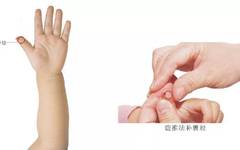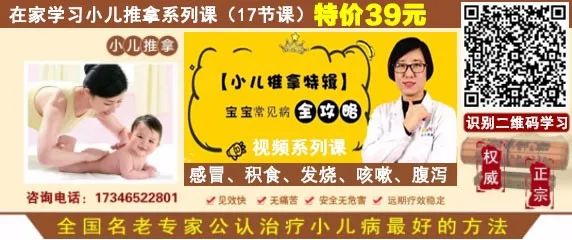
1. Spleen Meridian (Pi Jing)
Location:
① On the radial side of the thumb, from the fingertip to the transverse line of the interphalangeal joint (used for direct pushing method to tonify the Spleen Meridian);
② On the radial side of the thumb from the fingertip to the base (used for direct pushing method to clear and tonify the Spleen Meridian);
③ On the spiral surface of the thumb (used for the rotary pushing method to tonify the Spleen Meridian).
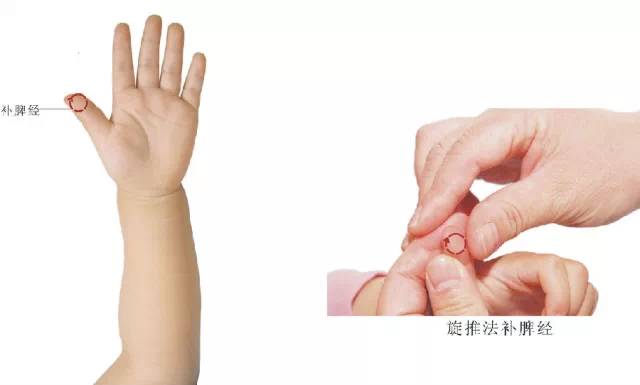
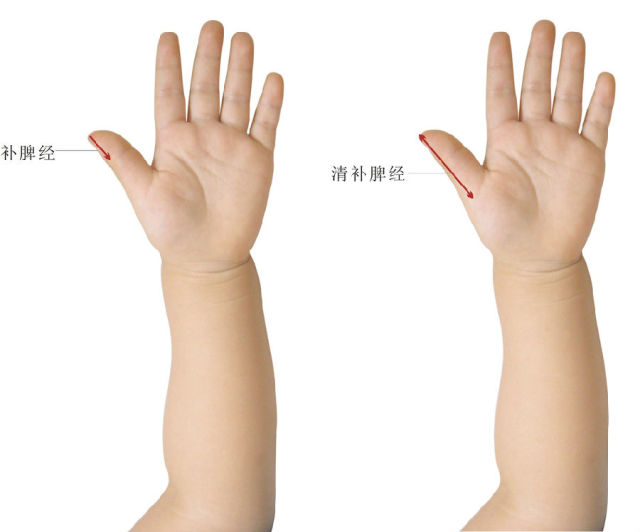
Operation:The practitioner uses the ring finger and little finger of the left hand to hold the child’s hand, while the index finger and thumb pinch the child’s thumb, and the right thumb pushes it.
① Direct pushing method: Flex the child’s thumb and push from the fingertip to the transverse line of the interphalangeal joint, called tonifying the Spleen Meridian (or tonifying Spleen Earth);
② Extend the child’s thumb straight and push back and forth from the base to the fingertip, called clearing the Spleen Meridian (or clearing and tonifying the Spleen Meridian).
③ Rotary pushing method: Rotate the thumb surface clockwise to tonify, counterclockwise to drain. Generally, use 300-500 times.
Effects:The Spleen is the foundation of postnatal life; tonifying it can replenish deficiency and support weakness, nourish blood and generate muscle, promote appetite, transform phlegm, assist digestion, and stop diarrhea; clearing it can clear heat and drain dampness, digest food, and resolve accumulation.
Indications:Poor appetite, vomiting, diarrhea, malnutrition, dysentery, convulsions, jaundice, damp phlegm, atrophy, rashes, and changes in complexion.
Note:Experiments have shown that pushing to tonify the Spleen Meridian has the following effects: ① It promotes gastric motility; ② It can increase the acidity of gastric juice; ③ It can increase the secretion of gastric pepsin; ④ The effect on amylase is not significant.
2. Liver Meridian (Gan Jing)
Location:On the palm surface of the index finger.
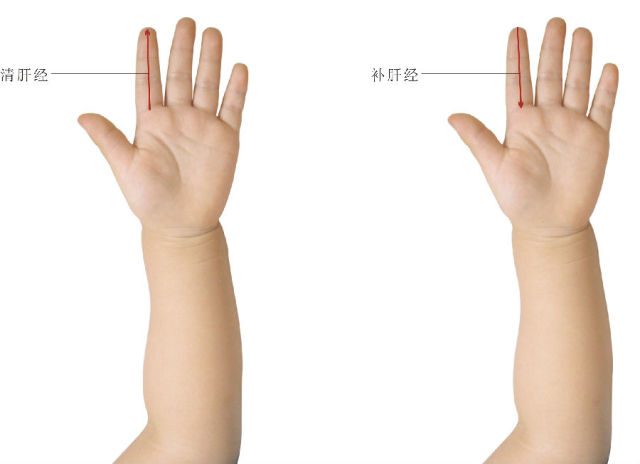
Operation:With the child’s index finger facing up, place it in the practitioner’s left hand, and push with the right thumb. Pushing from the base to the fingertip is called clearing the Liver Meridian (or calming the Liver or draining the Liver); pushing from the fingertip to the base is called tonifying the Liver Meridian. Generally, 100-500 times.
Effects:Relieve stagnation, eliminate irritability, calm Liver and Gallbladder fire, and settle wind and calm convulsions.
Indications:Red eyes, fainting, irritability, convulsions, bitter mouth, dry throat.
Note:The Liver Meridian is generally treated with clearing methods, not tonifying methods. If the Liver is deficient and needs tonifying, use the Kidney Meridian instead, as the Kidney nourishes the Liver. If the Liver is full or this point is not used, one can drain Heart fire or use the Clear Tianhe Water or Clear Small Intestine points instead, as the Liver is the mother of the Heart, and if it is full, one should drain its child; the Heart and Small Intestine are interrelated.
3. Heart Meridian (Xin Jing)
Location:On the palm surface of the middle finger.
Operation:With the child’s middle finger facing up, place it in the practitioner’s left hand, and push with the right thumb. Pushing from the base to the fingertip is called clearing the Heart Meridian; pushing from the fingertip to the base is called tonifying the Heart Meridian. 100-500 times.
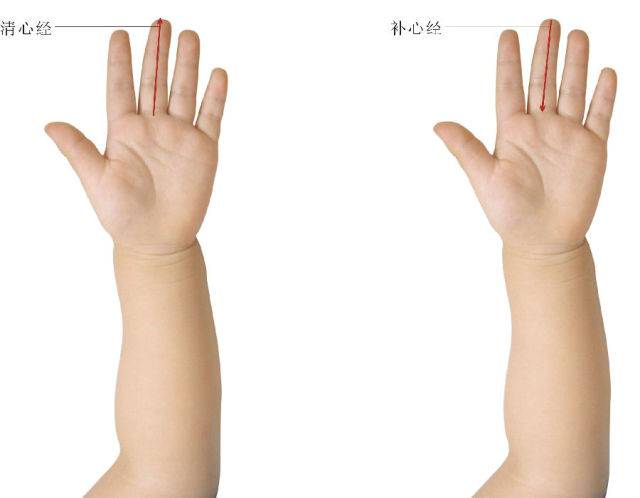
Effects:Clear heat, drain Heart fire, nourish Heart blood, and calm the mind.
Indications:Difficult urination, mouth sores, red eyes, five hearts heat, restlessness.
Note:The Heart Meridian is generally treated with draining methods, not tonifying methods, as Heart fire should not be recklessly activated. If Heart Qi is deficient or this point is not used, one can use the Clear Tianhe Water point instead. If the child has a high fever with redness on both cheeks, it indicates fire scorching gold, which may lead to severe coughing; draining methods should be used, and after 1-2 pushes, the redness on the cheeks may subside, which can also relieve severe coughing. However, this method is ineffective for children with tuberculosis who have redness on the cheeks.
4. Lung Meridian (Fei Jing)
Location:On the palm surface of the ring finger.
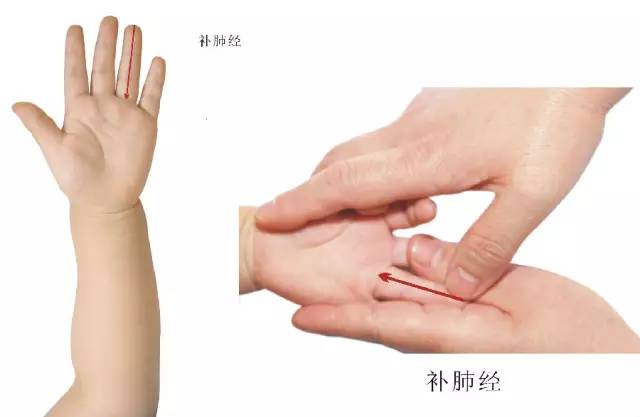
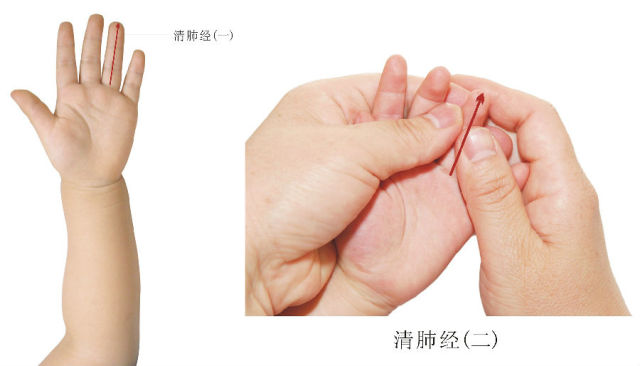
Operation:With the child’s ring finger facing up, place it in the practitioner’s left hand, and push with the right thumb. Pushing from the base to the fingertip or back and forth is called clearing the Lung Meridian; pushing from the fingertip to the base is called tonifying the Lung Meridian. 100-500 times.
Effects:Disperse Lung Qi, stop cough, regulate Qi, resolve phlegm, clear heat, and promote bowel movements.
Indications:Common cold, fever, cough, pneumonia, Lung deficiency, spontaneous sweating, night sweats, constipation, etc.
Note:The Lung Meridian is generally treated with clearing or draining methods, not tonifying methods. For children with chronic diarrhea or deficiency-cold diarrhea, caution should be exercised when using this point; the time for clearing this point should be short, or it should not be used. If urgent treatment is needed, clear this point 1-2 times, and once symptoms improve, stop using it. For spontaneous sweating, night sweats, and prolapse of the rectum, tonifying methods can be used; for Lung wind asthma, tonifying methods are prohibited.
5. Kidney Meridian (Shen Shui)
Location:On the palm surface of the little finger, in a straight line from the fingertip to the base.
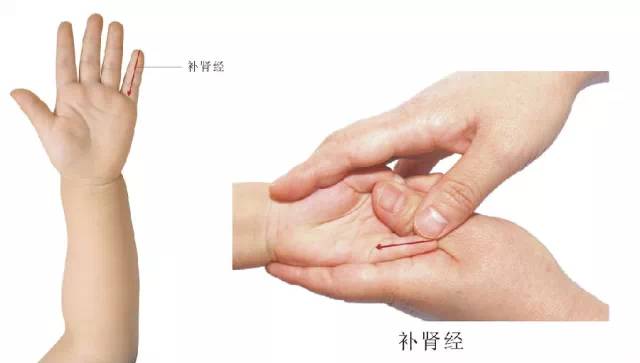
Operation:With the child’s little finger facing up, place it in the practitioner’s left hand, and push from the fingertip to the base with the right thumb, called tonifying the Kidney Meridian. 100-500 times.
Effects:The Kidney is the foundation of congenital life; tonifying the Kidney Meridian can nourish the brain, boost Qi, stabilize breathing, warm the lower source, and stop deficiency fire.
Indications:Early morning diarrhea, enuresis, frequent urination, Kidney deficiency cough, convulsions, epilepsy, toothache, weakness of bones, congenital insufficiency.
6. Large Intestine Meridian (Da Chang)
Location:On the radial side of the index finger, in a straight line from the fingertip to the base.
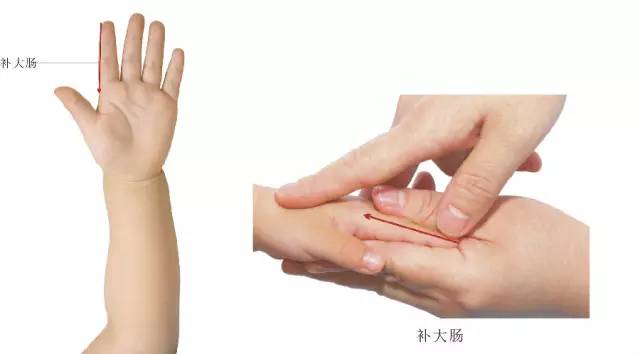
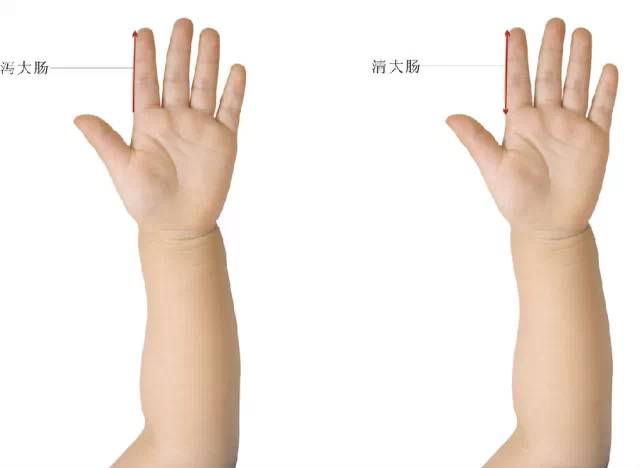
Operation:Fix the child’s index finger in the practitioner’s left hand, and push with the right thumb on the outer edge. Pushing from the fingertip to the base is called tonifying the Large Intestine; pushing from the base to the fingertip is called draining the Large Intestine; back and forth pushing is called clearing the Large Intestine. 100-500 times.
Effects:Tonifying can firm the intestines and stop diarrhea; draining can clear and benefit the damp-heat of the viscera, and balance tonifying and draining to guide stagnation.
Indications:Food accumulation, mouth sores, dysentery, diarrhea, anal redness and swelling, prolapse of the rectum, rectal inversion, constipation.
Note:The Large Intestine has the function of firming the intestines and stopping diarrhea, but in cases of watery diarrhea (i.e., damp-heat diarrhea), the focus should be on diuresis. When pushing the Large Intestine, first use draining or clearing methods, and after urination increases, then use tonifying methods; in cases of urgency, first drain the Large Intestine, and after symptoms improve, switch to clearing or tonifying the Large Intestine. For deficiency syndromes and prolapse of the rectum, tonifying methods should be used; for rectal inversion, anal redness and swelling, and constipation, draining or clearing methods should be used.
7. Small Intestine Meridian (Xiao Chang)
Location:On the ulnar side of the little finger, in a straight line from the base to the fingertip.
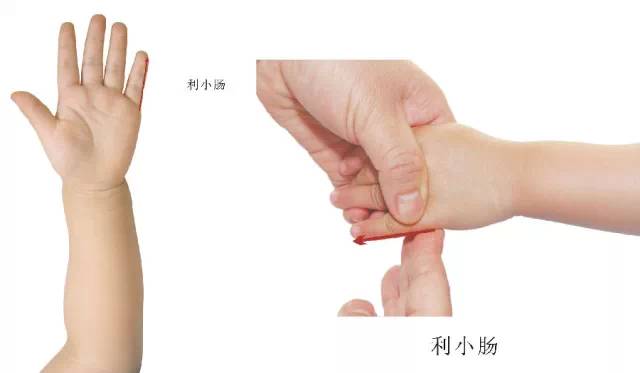
Operation:With the child standing, the practitioner uses the thumb and the other four fingers to hold the child’s four fingers, exposing the ulnar side of the little finger, and then pushes with the right thumb from the base to the fingertip, called clearing the Small Intestine (or benefiting the Small Intestine or pushing the Small Intestine). Generally, 100-500 times; if pushing the Small Intestine alone, it can be pushed 1000 times (if there is no urination).
Effects:Separate clear from turbid, drain heat, and promote urination.
Indications:Watery diarrhea with no urination, frequent urination, urinary retention, low urination, mouth sores, tongue protrusion, tongue manipulation, wooden tongue, lip fissures, urinary tract infection.
8. Xiaotianxin (Fish Junction)
Location:In the center of the palm root, in the depression between the big and small fish junctions, at the intersection of Yin and Yang pools.
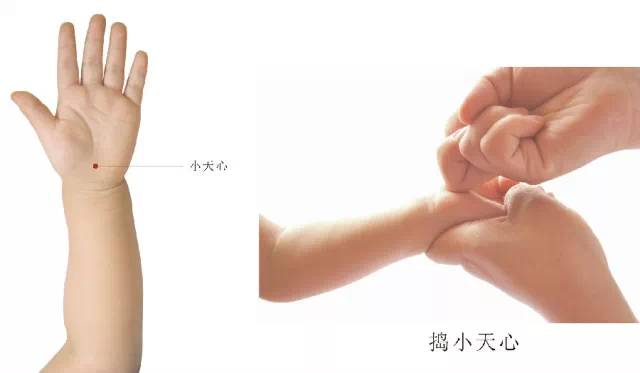
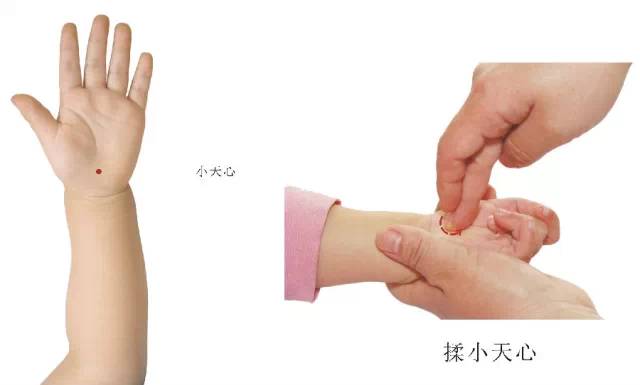
Operation:Have the child’s palm facing up, rub with the tip of the middle finger or thumb, or use a half-closed fist with the first and second sections of the index and middle fingers to pound it. Rub 100-500 times; pinch 3-5 times; pound 5-20 times.
Effects:Open orifices, disperse masses, smooth meridians, calm the mind, clear heat, promote urination, improve vision, and correct muscle tension or dominance.
Indications:Common cold with fever, unconsciousness, irritability, convulsions, epilepsy, insomnia, night crying, all eye diseases, difficult urination, rashes and pox that do not surface, and head relief.
9. Yin and Yang
Location:At the base of the palm, on both sides of the Xiaotianxin point, with the thumb side being Yang Pool and the little finger side being Yin Pool.
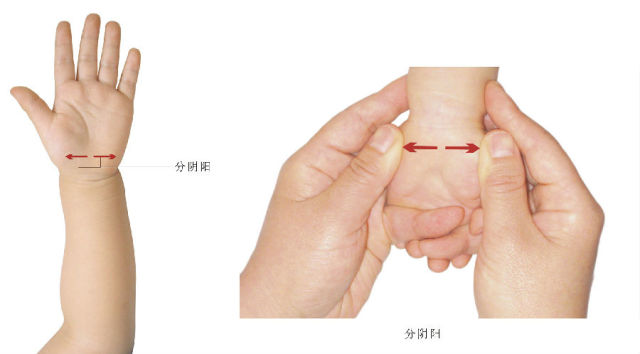
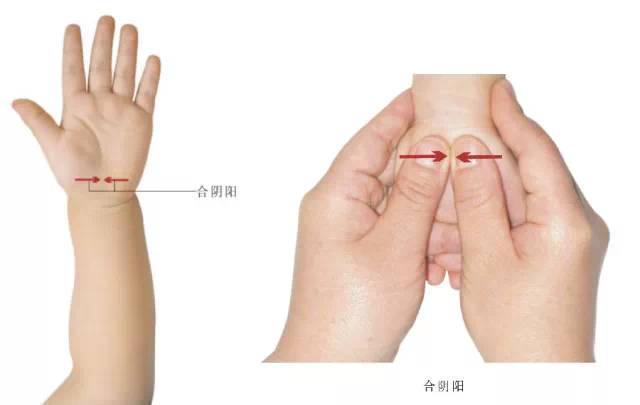
Operation:The practitioner uses both thumbs to push from the Xiaotianxin point outward, called separating Yin and Yang; from the sides of the Xiaotianxin point (Yin Pool and Yang Pool) towards the Xiaotianxin point, called combining Yin and Yang. 100-300 times.
Effects:Separating Yin and Yang harmonizes the viscera and balances Yin and Yang; combining Yin and Yang helps disperse phlegm and resolve masses.
Indications:Common cold with fever, alternating cold and heat, red and white dysentery, enteritis, convulsions, and diarrhea, vomiting, jaundice; phlegm and fluid accumulation, chest tightness, and cough.
10. Banmen (Board Gate)
Location:Under the thumb, on the plane of the big fish junction of the palm.
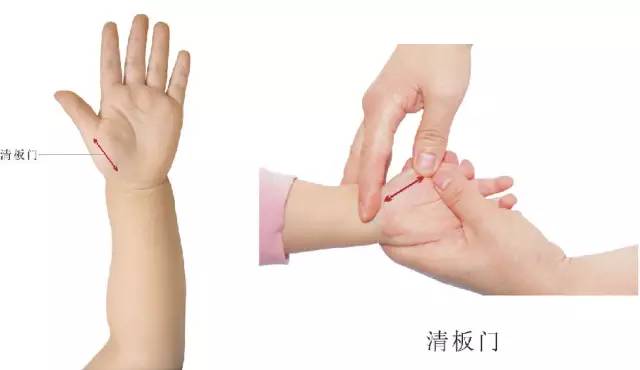
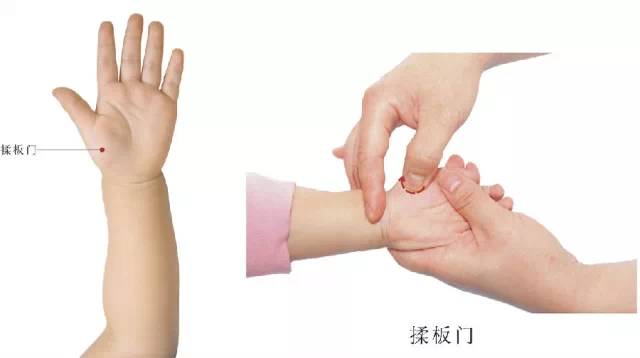
Operation:Expose the child’s big fish junction, and the practitioner uses the right thumb to push back and forth, called clearing the Banmen; using the fingertip to rub the midpoint of the big fish junction plane, called rubbing the Banmen. 100-500 times.
Effects:Clear heat, cool blood, stop bleeding, eliminate irritability, digest food, and resolve accumulation, with the function of ascending and descending.
Indications:Poor appetite, vomiting, diarrhea, common cold with fever, persistent high fever, Yin deficiency with internal heat, rashes and pox that do not subside or low fever after rashes and pox, irritability, bad breath, nasal bleeding, nasal inflammation, red and swollen upper gums, smooth tongue, thick coating, etc.
11. Neilaogong (Inner Labor Palace)
Location:In the center of the palm.
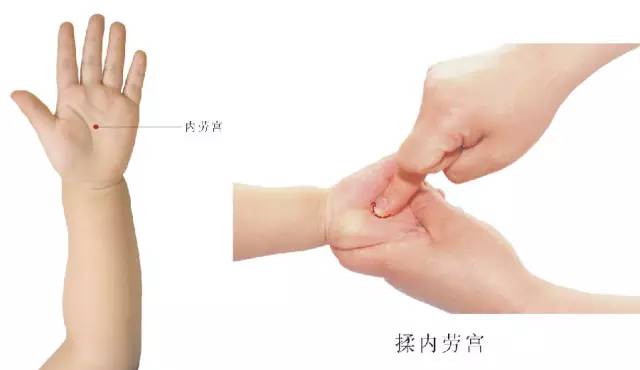
Operation:Pinch and rub with the thumb or middle finger, called pinching and rubbing Neilaogong; use the tip of the middle finger to press the center of the child’s palm with slight force and quickly lift it, called pressing Neilaogong; drop a few drops of cool water in the palm center, and use the fingertip to move in reverse at Neilaogong, or move from the palm surface of the little finger to the palm center, called moving Neilaogong or fishing for the moon at the bottom of the water. Rub 100-300 times, move 10-30 times, pinch 3-5 times.
Effects:Clear heat, eliminate irritability, and drain Heart fire.
Indications:All heat syndromes, fever, thirst, irritability, restless sleep, mouth sores, red eyes, and difficult urination.
12. Neibagua (Inner Eight Trigrams)
Location:In the palm. Taking the left hand as an example, with the palm root at the top as north, using Neilaogong as the center, draw a circle with a radius from Neilaogong to 2/3 of the transverse line of the middle finger root.
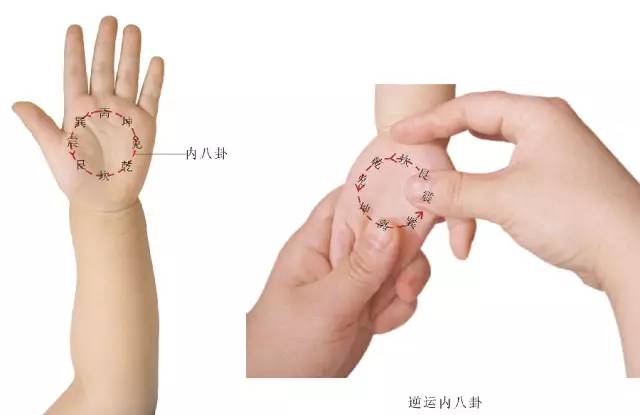
Operation:The practitioner supports the child’s four fingers with the left hand, palm facing up, and uses the outer edge of the right thumb to push on the points, pushing clockwise is called clockwise Neibagua; counterclockwise is called counterclockwise Neibagua. 100-300 times.
Effects:Open the chest, resolve phlegm, benefit Qi, and relieve fullness.
Indications:Cough with phlegm, vomiting, food accumulation, poor appetite, diarrhea, abdominal distension, and irritability.
13. Four Horizontal Lines
Location:At the transverse lines of the second to fifth fingers at the junction of the fingers and palm.
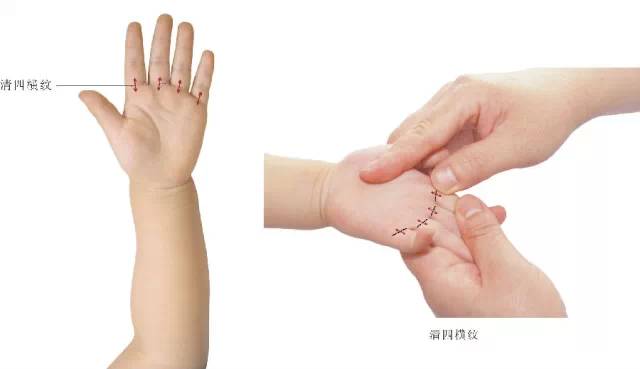
Operation:With the child’s palm facing up, use the radial edge of the thumb to push back and forth from the transverse lines of the index, middle, ring, and little fingers, called clearing the four horizontal lines (pushing the four horizontal lines) or pinching the four horizontal lines; pushing the four horizontal lines can also be done by rubbing back and forth at the transverse lines of the four fingers. Each horizontal line should be pushed 50-200 times (if used alone, 800 times) or pinched 5-8 times.
Effects:Regulate the middle, promote Qi, harmonize Qi and blood, relieve fullness, reduce heat, eliminate irritability, and disperse stagnation.
Indications:Abdominal distension, mouth sores, lip fissures, food injury, malnutrition, poor appetite, etc.
Note:The four horizontal lines are one of the commonly used points in this method, often used to relieve abdominal distension and treat mouth sores, especially effective for ulcers on the upper and lower lips.
15. Small Horizontal Lines
Location:On the raised area below the transverse line of the little finger and above the palm transverse line.
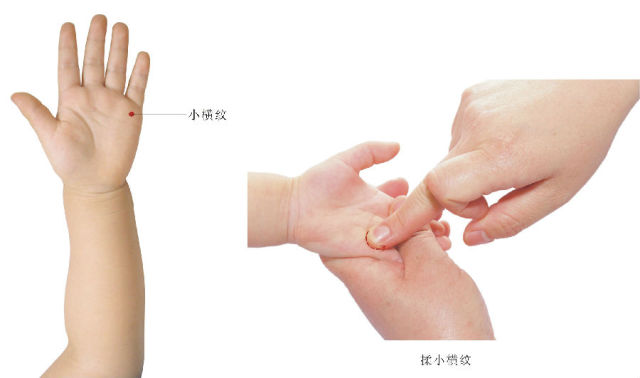
Operation:With the child’s palm facing up, the practitioner rubs with the middle finger of the right hand, called rubbing the small horizontal lines. 100-500 times.
Effects:Clear heat, disperse masses, and stop cough and resolve phlegm.
Indications:All cough and asthma syndromes, mouth and tongue sores.
Note:This point is effective for respiratory diseases.
15. Kidney Top (Shen Ding)
Location:At the tip of the little finger.
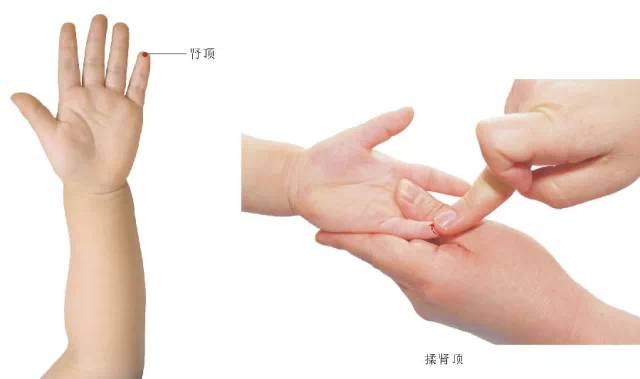
Operation:The practitioner uses the left hand to hold the child’s little finger, and the right middle finger rubs it, called rubbing the Kidney Top. 100-500 times.
Effects:Consolidate vital energy, secure the exterior, and stop sweating.
Indications:Spontaneous sweating, night sweats, head relief, and water hernia.
16. Kidney Lines (Shen Wen)
Location:At the transverse line of the tip of the little finger.
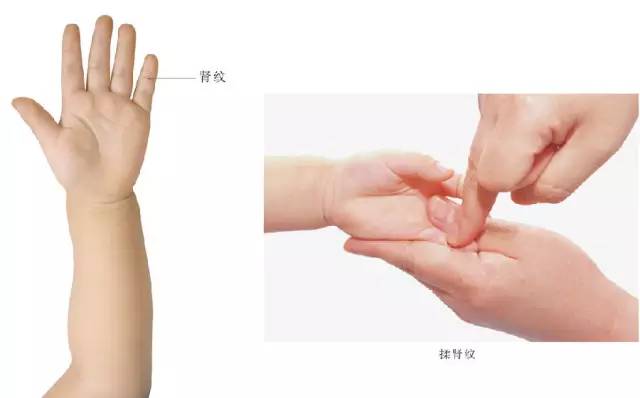
Operation:The practitioner uses the left hand to hold the child’s little finger, and the right middle finger rubs it, called rubbing the Kidney Lines. 100-500 times.
Effects:Disperse heat, and guide internal heat outward.
Indications:Red eyes, internal heat toxins, internal heat with external cold, high fever with cold hands and feet, etc.
17. Water into Soil (Yun Shui Ru Tu)
Location:From the tip of the little finger (Kidney Water point) to the radial side of the thumb (Spleen Earth point), along the edge of the palm in an arc.
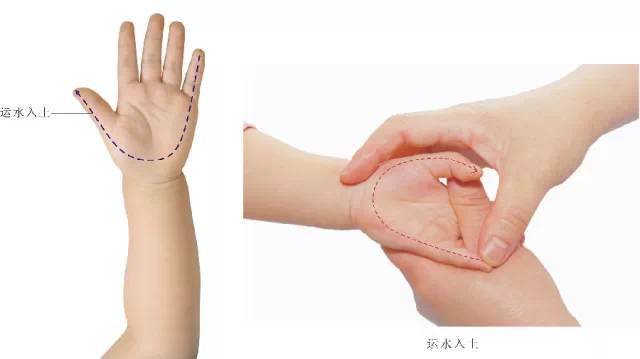
Operation:Start from the tip of the little finger, along the edge of the palm, and push from the Xiaotianxin point to the radial side of the thumb. 100-300 times.
Effects:Strengthen the Spleen, assist transportation, and moisten dryness to promote bowel movements.
Indications:Often used for Spleen and Stomach weakness leading to undigested food, diarrhea, dysentery, constipation, and malnutrition.
18. Soil into Water (Yun Tu Ru Shui)
Location:From the radial side of the thumb (Spleen Earth point) to the tip of the little finger (Kidney Water point), along the edge of the palm in an arc.
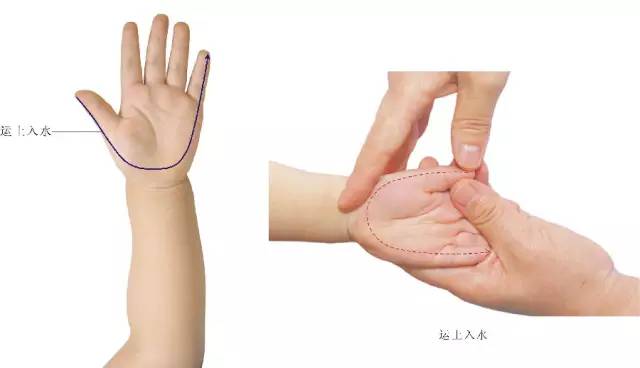
Operation:Start from the radial side of the thumb, along the edge of the palm, and push from the Xiaotianxin point to the tip of the little finger. 100-300 times.
Effects:Clear damp-heat from the Spleen and Stomach, and replenish Kidney water deficiency.
Indications:Often used for new syndromes, excess syndromes, such as fullness in the lower abdomen, diarrhea, dysentery, and red and painful urination due to internal damp-heat.
19. Total Tendon (Zong Jin)
Location:At the midpoint of the wrist transverse line.
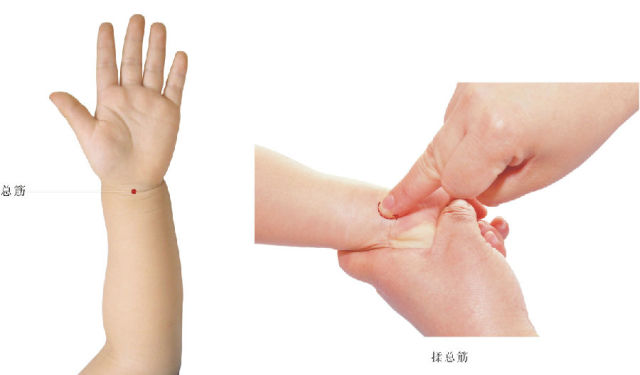
Operation:The practitioner supports the child’s hand with the left hand, palm facing up, and rubs with the middle finger of the right hand, called rubbing the Total Tendon; or pinching or rubbing it, called pinching the Total Tendon or rubbing the Total Tendon. Rub 100-300 times, pinch 3-5 times.
Effects:Drain heat, disperse masses, and regulate Qi throughout the body.
Indications:Heat in the Heart Meridian, convulsions, night crying, tidal heat, mouth sores, and all excess heat syndromes.
Note:This point is one of the main points for treating mouth sores, especially effective for ulcers on the tip and surface of the tongue.
20. Tianhe Water (Tianhe Shui)
Location:On the inner side of the forearm, in a straight line from the midpoint of the wrist transverse line (Total Tendon) to the midpoint of the elbow transverse line (Quze).
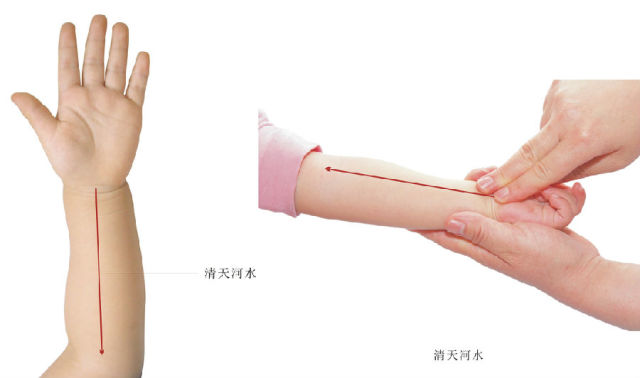
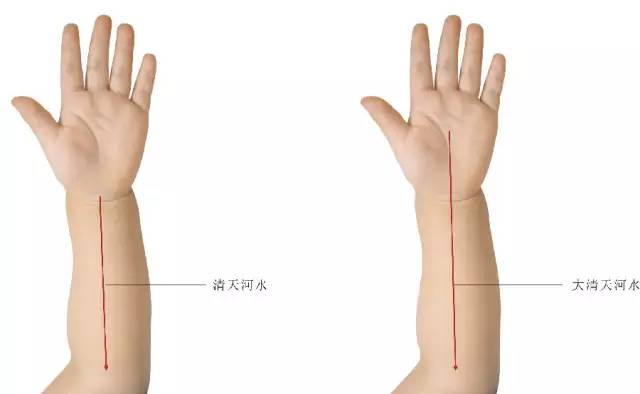
Operation:1. Clear Tianhe Water: The practitioner supports the child’s forearm and wrist with the left hand, palm facing up, and uses the thumb or index and middle fingers together to push from the Total Tendon point to the Quze point, called clearing Tianhe Water (all points pushed towards the heart are tonifying, but only Tianhe Water is cleared towards the heart). This point is often treated with clearing methods, 100-300 times.
2. Great Clear Tianhe Water: On the palm surface of the forearm, push from Neilaogong to Quze, called Great Clear Tianhe Water. The method and pushing method are the same. 100-300 times.
3. Horse Riding over Tianhe Water: The method is the same as above; the practitioner first uses the right middle finger to move Neilaogong, then uses the tips of the index and middle fingers dipped in cool water to flick from Total Tendon, Neiguan, and Jianshi along Tianhe Water to the Hongchi point (Quze point). Please follow the public account for acupuncture, scraping, cupping, and bloodletting; various TCM skills are available here. Each point should be flicked 3-5 times for one treatment, and a total of 3 treatments.
Effects:Clear heat, eliminate irritability, calm the mind, drain Heart fire, and promote urination.
Indications:External heat, thirst, dry mouth, irritability, night crying, restless sleep, mouth sores, heavy tongue, wooden tongue, tongue protrusion, tongue manipulation, phlegm and cough, and short and painful urination, all heat syndromes.
21. Three Passes (Upper Three Passes)
Location:On the radial side of the forearm, in a straight line from the wrist transverse line to the elbow transverse line.
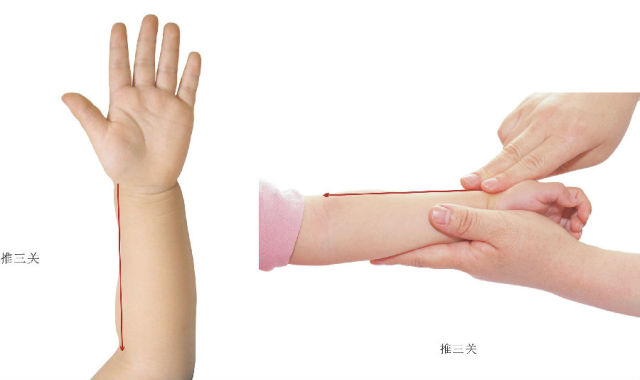
Operation:Have the child in a palm-up position, with the palm facing inward. The practitioner supports the child’s ulnar wrist joint with the left hand, and the index and middle fingers are together to support the child’s forearm, using the right thumb or the tips of the index and middle fingers to push along the radial side of the forearm from the wrist transverse line to the elbow transverse line, called pushing the Three Passes. 100-300 times.
Effects:Tonify deficiency, support weakness, assist Qi and blood, nourish vital energy, warm Yang, disperse cold, and induce sweating.
Indications:All deficiency-cold syndromes, malnutrition anemia, jaundice, paralysis, rashes that do not surface, weakness of the lower limbs (infantile paralysis), and sores (non-purulent stage, helps with suppuration).
22. Six Fu (Retreating Six Fu)
Location:On the ulnar side of the forearm, in a straight line from the elbow transverse line to the wrist transverse line.
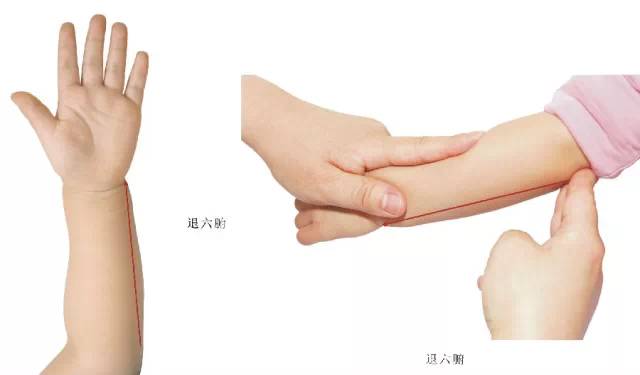
Operation:Have the child in a palm-up position, with the palm facing inward. The practitioner holds the child’s radial wrist joint with the left hand, and uses the right thumb or the tips of the index and middle fingers to push along the ulnar side of the forearm from the elbow transverse line to the wrist transverse line, called retreating the Six Fu. 100-300 times.
Effects:Cool blood, reduce heat, and detoxify.
Indications:All excess heat syndromes, persistent high fever, convulsions, mouth sores, heavy tongue, wooden tongue, swollen gums, sore throat, mumps, red dysentery, constipation, unidentified swelling and toxins, and sores (red and swollen stage).
23. Yiwowfeng (One Nest of Bees)
Location:In the center of the wrist transverse line on the back of the hand.
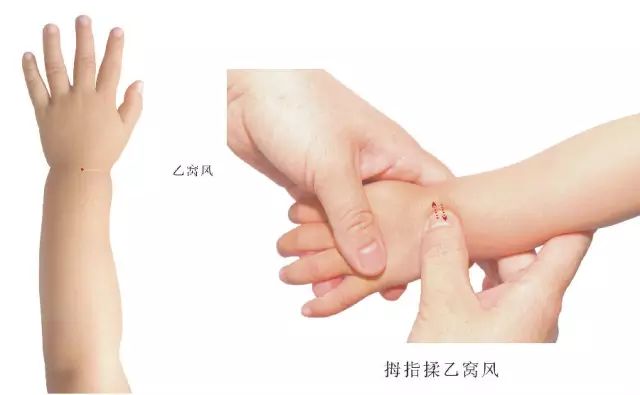
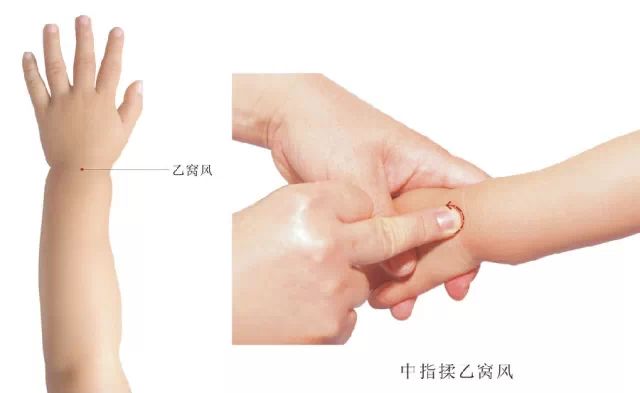
Operation:With the child’s palm facing down, the practitioner rubs with the middle finger or thumb, called rubbing Yiwowfeng. 100-500 times.
Effects:Disperse wind-cold, promote circulation inside and outside, warm the middle, regulate Qi, and relieve pain.
Indications:Common cold, abdominal pain, pain, acute and chronic convulsions.
Note:The thumb rubs are mainly used to disperse wind-cold. The middle finger rubs are mainly used to warm the middle, regulate Qi, and relieve pain.
24. Wailao Palace (Outer Labor Palace)
Location:In the center of the back of the hand, opposite to Neilaogong.
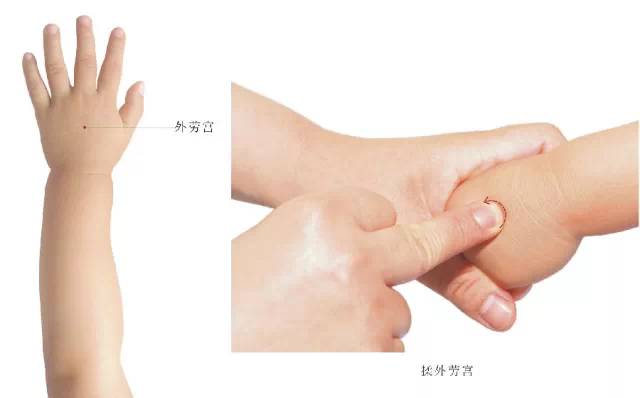
Operation:The practitioner supports the child’s four fingers, palm facing down, and rubs with the right thumb or middle finger, called rubbing the Wailao Palace. 100-300 times.
Effects:Warm the middle, disperse cold, secure the lower source, and raise Yang.
Indications:Abdominal rumbling and pain, diarrhea, cold dysentery, green or unformed stools, mucus in stools, hernia, prolapse of the rectum, enuresis, and abdominal pain from roundworms.
Note:This point is the main point for tonifying Yang; it is warm and can reach inside and disperse outside. Please follow the public account for acupuncture, scraping, cupping, and bloodletting; various TCM skills are available here. Rubbing can induce sweating; for any cold and stagnant conditions in the viscera, it has a warming effect, but it also has a consolidating effect, preventing excessive warming and dispersing.
25. Erma (Two Horses)
Location:In the depression behind the small heads of the fourth and fifth metacarpals on the back of the hand.
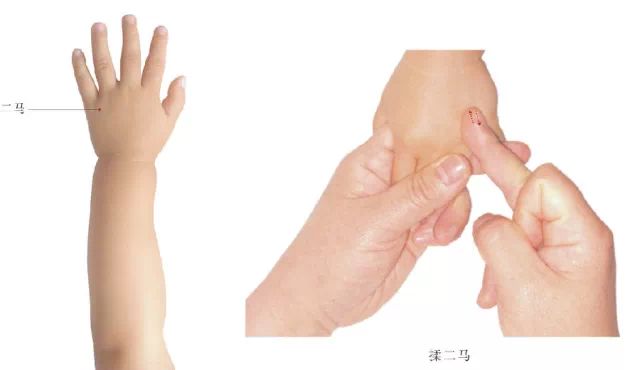
Operation:With the child’s palm facing down, the practitioner places the index finger under the child’s small horizontal line point, while the other fingers hold the child’s index, middle, and ring fingers, widening the gap between the little finger and the ring finger for easier access to the point. The right thumb or middle finger is inserted diagonally into the point and moved up and down, called rubbing Erma. 100-500 times.
Effects:Tonify Kidney, guide fire back to the source, promote Qi, disperse masses, and promote urination.
Indications:Urinary retention, dysuria, phlegm-dampness, cough and asthma, toothache, bruxism during sleep, chronic illness, night crying, and dry cough.
26. Weiling (Weiling)
Location:Beside the Wailao Palace, between the second and third metacarpals on the back of the hand.
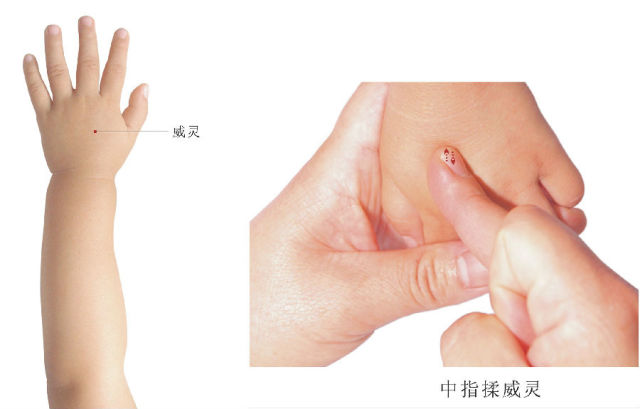
Operation:With the child’s palm facing down, the practitioner pinches or rubs with the right thumb or middle finger, called pinching or rubbing Weiling. Pinch and rub 200-300 times, pinch 5-10 times.
Effects:Open orifices, awaken the spirit, clear the mind, and stop convulsions.
Indications:Acute convulsions, unconsciousness, headache, high fever with unconsciousness, and are critical rescue points.
Accompanying Points:Pinching Weiling can be paired with pinching Ren Zhong, pinching Shixuan, pinching Pucan, and pinching Jingning for emergency treatment.
Precautions
1. Pediatric tuina is suitable for children aged 0-12 years.
2. When performing pediatric tuina, choose a place that avoids wind, strong light, and noise; the room should be quiet, clean, with fresh air and suitable temperature. After pediatric tuina, avoid wind and refrain from eating raw or cold foods.
3. During pediatric tuina, parents should keep their hands clean, remove rings, bracelets, and other ornaments. Nails should be trimmed regularly, and freshly cut nails should be smoothed with a nail file. In winter, hands should be kept warm during tuina.
4. Children who are overly hungry or overly full are not conducive to the effectiveness of pediatric tuina. When children cry, first calm their emotions before performing tuina.
5. Children’s skin is delicate; do not scratch the child’s skin during tuina. For family tuina, massage oil or talcum powder can be used to prevent skin damage during tuina.

6. The sequence of pediatric tuina techniques: generally, start with the head and face, then the upper limbs, followed by the chest, abdomen, back, and finally the lower limbs; or focus on key points first, then general points; or start with main points, then accompanying points. Strong stimulation techniques such as “pinching, kneading, pounding,” etc., should generally be performed last, except in emergencies, to avoid causing the child to cry and disrupt the treatment.
The duration of pediatric tuina should be determined based on the condition and constitution, as it varies from person to person. In clinical practice, pushing and rubbing methods are used more frequently, with rubbing methods taking longer. When using pinching and pressing methods, the technique should be heavy, less, and fast. If only one side of the hand points is pushed, regardless of gender, the left hand should be pushed.
7. Generally, the total time for pediatric tuina is 10-20 minutes. However, due to differences in conditions and children’s ages, there may be variations in the number of treatments and duration. Older children with more severe conditions may require more treatments and longer duration. Conversely, fewer treatments and shorter duration.
Generally, once a day, for severe cases, twice a day. For chronic diseases requiring long-term treatment, 7-10 days is one treatment cycle. After one treatment cycle, a few days of rest can be taken before starting the next treatment cycle. For pediatric tuina, regular treatments can be performed once a day or every other day for different systems. During tuina, fewer points can be selected for treatment, the stimulation level should be slightly lower, and the duration can be maintained at around 15 minutes.
8. The basic requirements for pediatric tuina techniques are: even, gentle, brisk, and lasting.
9. When performing pediatric tuina techniques, pay attention to the child’s position; in principle, it should be comfortable for the child, eliminating fear, and facilitating operation.
10. Contraindications for pediatric tuina include: fractures, traumatic bleeding; skin damage, skin ulcers; burns, scalds; acute, severe infectious diseases; cancer and critical illnesses, etc.
11. It is best to target only one issue when performing pediatric tuina. If the health and treatment goals are too many and the points are too mixed, it will affect the final effect.
12. Lastly, and most importantly, the pediatric tuina network reminds you: before pediatric tuina treatment, a clear diagnosis must be made. If parents are unsure, please take the child to the hospital for diagnosis! Children’s diseases change rapidly and require immediate attention; parents should not be negligent.


